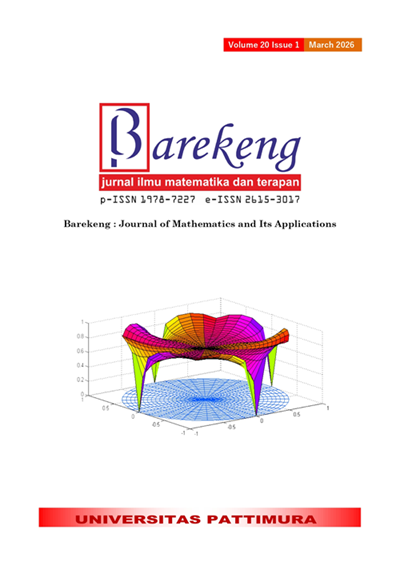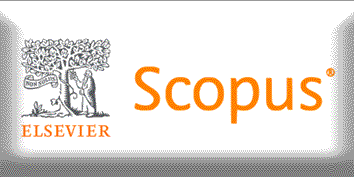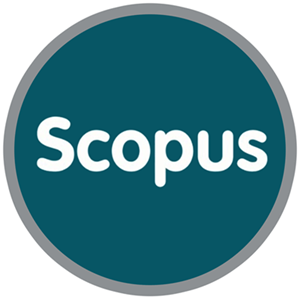APPLICATION OF COOPERATIVE GAME THEORY: SOLVING THE PROBLEM OF TRAVELING BETWEEN FIVE CITIES IN JAVA
Abstract
Intercity travel between Surabaya, Madiun, Surakarta, Semarang, Cirebon, and Jakarta is increasingly facilitated by integrated infrastructure such as toll roads, railways, and airports. Among travelers, forming informal coalitions with others heading in the same direction has become a practical way to reduce individual travel expenses. This study aims to analyze the cost-efficiency of coalition-based intercity travel compared to solo travel, utilizing cooperative game theory to determine fair contribution values among travelers. This study aims to analyze the cost-efficiency of coalition-based intercity travel compared to solo travel, utilizing cooperative game theory to determine fair contribution values among travelers. A case study was conducted in an urban setting involving individuals who travel intercity using various transportation modes. Data were collected through semi-structured interviews. The study applied the Shapley value method within cooperative game theory to model and evaluate each participant’s contribution in a travel coalition. An algorithm was developed to calculate Shapley values for different coalition scenarios. Initial expenditures were: Player A (IDR 210,000), B (IDR 240,000), C (IDR 60,000), D (IDR 400,000), and E (IDR 165,000). First calculation (5-player coalition): A spent IDR 122,750, B IDR 147,750, C IDR 77,750, D IDR -52,250, and E IDR 104,000. Player C opted out, as joining the coalition would cost more than traveling individually (IDR 60,000). Second calculation (4-player coalition): A spent IDR 113,750, B IDR 133,750, D IDR 53,750, and E IDR 98,750. The study’s findings are based on a small sample with specific subject criteria and cannot be generalized to broader intercity travel scenarios. This research demonstrates the practical application of game theory—specifically the Shapley value—in modeling travel coalitions and optimizing cost distribution, offering insights for policy makers and transport planners in collaborative travel schemes.
Downloads
References
A. Shahmohammadian and M. Ghafory-Ashtiany, “GAME THEORY APPLICATIONS IN MANAGING STAKEHOLDER CONFLICTS FOR BUILDING SAFETY AND RESILIENCE AGAINST NATURAL DISASTERS,” Progress in Disaster Science, vol. 26, p. 100409, 2025. doi: https://doi.org/10.1016/j.pdisas.2025.100409.
O. Chatain, “COOPERATIVE AND NON-COOPERATIVE GAME THEORY,” in The Palgrave Encyclopedia of Strategic Management, M. Augier and D. J. Teece, Eds., London: Palgrave Macmillan UK, 2016, pp. 1–3. doi: https://doi.org/10.1057/978-1-349-94848-2_468-1
T. Hazra, K. Anjaria, A. Bajpai, and A. Kumari, “COOPERATIVE GAME THEORY,” in Applications of Game Theory in Deep Learning, T. Hazra, K. Anjaria, A. Bajpai, and A. Kumari, Eds., Cham: Springer Nature Switzerland, 2024, pp. 13–22. doi: https://doi.org/10.1007/978-3-031-54653-2_2.
B. Peleg and P. Sudhölter, INTRODUCTION TO THE THEORY OF COOPERATIVE GAMES, 2nd ed. Springer Berlin, Heidelberg, 2007. doi: https://doi.org/10.1007/978-3-540-72945-7.
A. Tatarczak and P. Dehez, “HORIZONTAL COOPERATION IN LOGISTICS - GAME THEORY APPROACH,” www.meito.pl.
Y. Yusmiati, M. Machfud, M. Marimin, and T. C. Sunarti, “DISTRIBUSI KEUNTUNGAN YANG ADIL ANTAR AKTOR RANTAI PASOK AGROINDUSTRI SAGU DI KABUPATEN KEPULAUAN MERANTI, RIAU,” Jurnal Teknologi Industri Pertanian, vol. 33, no. 2, pp. 105–116, 2023. doi: https://doi.org/10.24961/j.tek.ind.pert.2023.33.2.105
N. Hasanah, T. Yulianto, and I. Yudistira, “PENENTUAN STRATEGI PEMASARAN DARI PENJUALAN AIR MINUM DALAM KEMASAN LOKAL DAN NASIONAL MENGGUNAKAN METODE FUZZY SHAPLEY VALUE,” Zeta-Math Journal, vol. 6, no. 2, pp. 54–61, 2021. doi: https://doi.org/10.31102/zeta.2021.6.2.54-61
R. Moeckel, R. Fussell, and R. Donnelly, “MODE CHOICE MODELING FOR LONG-DISTANCE TRAVEL,” Transportation Letters, vol. 7, no. 1, pp. 35–46, 201. doi: https://doi.org/10.1179/1942787514Y.0000000031.
X. Tan, Q. Deng, and X. Hu, “RESEARCH ON VEHICLE CARRYING EFFICIENCY OF THREE-LANE EXPRESSWAY BASED ON DEA METHOD,” Transportation Letters, vol. 14, no. 8, pp. 838–848, 2022. doi: https://doi.org/10.1080/19427867.2021.1950267.
Y. Widyaningsih and A. C. Nisa, “COMPARISON BETWEEN BICLUSTERING AND CLUSTER-BIPLOT RESULTS OF REGENCIES/CITIES IN JAVA BASED ON PEOPLE’S WELFARE INDICATORS,” Barekeng, vol. 19, no. 2, pp. 1009–1022, Jun. 2025. doi: https://doi.org/10.30598/barekengvol19iss2pp1009-1022.
J. Carpenter and A. Robbett, GAME THEORY AND BEHAVIOR. MIT Press, 2022.
J. R. Marden and J. S. Shamma, “ANNUAL REVIEW OF CONTROL, ROBOTICS, AND AUTONOMOUS SYSTEMS GAME THEORY AND CONTROL,” 2025. doi: https://doi.org/10.1146/annurev-control-060117.
N. Z. Rizkita, Sutanto, and N. A. Kurdhi, “GAME THEORY AND MARKOV CHAIN ANALYSIS OF THE DISPLACEMENT OF SHOPPING MALL VISITORS IN SURAKARTA CITY,” Barekeng, vol. 19, no. 2, pp. 1047–1056, Jun. 2025, doi: https://doi.org/10.30598/barekengvol19iss2pp1047-1056.
S. Abapour, M. Nazari-Heris, B. Mohammadi-Ivatloo, and M. Tarafdar Hagh, “GAME THEORY APPROACHES FOR THE SOLUTION OF POWER SYSTEM PROBLEMS: A COMPREHENSIVE REVIEW,” Archives of Computational Methods in Engineering, vol. 27, no. 1, pp. 81–103, 2020 doi: https://doi.org/10.1007/s11831-018-9299-7.
M. S. Sinaga, A. Arnita, Y. M. Rangkuti, and D. Febrian, “GAME THEORY APPLICATION ON ONLINE TRANSPORTATION COMPANY AND DRIVER INCOME LEVELS DURING THE PANDEMIC,” BAREKENG: Jurnal Ilmu Matematika dan Terapan, vol. 16, no. 2, pp. 713–720, Jun. 2022. doi: https://doi.org/10.30598/barekengvol16iss2pp713-720.
P. D. Straffin, GAME THEORY AND STRATEGY, no. v. 36. in Anneli Lax New Mathematical Library. Mathematical Association of America, 1993. [Online]. Available: https://books.google.co.id/books?id=3TB3m3RvAlcC
R. Serrano, COOPERATIVE GAMES: CORE AND SHAPLEY VALUE 1 COOPERATIVE GAMES: CORE AND SHAPLEY VALUE. 2007.
G. Owen, Game Theory. in unknown. Emerald Group Publishing Limited, 2013. [Online]. Available: https://books.google.co.id/books?id=yeVbAAAAQBAJ
T. AlSkaif, M. Guerrero Zapata, and B. Bellalta, “GAME THEORY FOR ENERGY EFFICIENCY IN WIRELESS SENSOR NETWORKS: LATEST TRENDS,” Journal of Network and Computer Applications, vol. 54, pp. 33–61, 2015. doi: https://doi.org/10.1016/j.jnca.2015.03.011.
U. Suryani and M. W. Musthofa, “PERMAINAN KOOPERATIF BENTUK KOALISI,” LOGIK@, vol. 8, no. 2, pp. 80–86, 2018.
L. S. Shapley, “A VALUE FOR N-PERSON GAMES,” 1953. doi: https://doi.org/10.1515/9781400881970-018
M. Li, H. Sun, Y. Huang, and H. Chen, “SHAPLEY VALUE: FROM COOPERATIVE GAME TO EXPLAINABLE ARTIFICIAL INTELLIGENCE,” Autonomous Intelligent Systems, vol. 4, no. 1, p. 2, 2024. doi: https://doi.org/10.1007/s43684-023-00060-8.
M. Sundararajan and A. Najmi, “THE MANY SHAPLEY VALUES FOR MODEL EXPLANATION,” in Proceedings of the 37th International Conference on Machine Learning, H. D. III and A. Singh, Eds., in Proceedings of Machine Learning Research, vol. 119. PMLR, Jun. 2020, pp. 9269–9278. [Online]. Available: https://proceedings.mlr.press/v119/sundararajan20b.html
A. Kolker, “THE CONCEPT OF THE SHAPLEY VALUE AND THE COST ALLOCATION BETWEEN COOPERATING PARTICIPANTS,” 2017, pp. 2095–2107. doi: https://doi.org/10.4018/978-1-5225-2255-3.ch182.
Copyright (c) 2025 Muhammad Aditya Tri Ariyanto, Rubono Setiawan

This work is licensed under a Creative Commons Attribution-ShareAlike 4.0 International License.
Authors who publish with this Journal agree to the following terms:
- Author retain copyright and grant the journal right of first publication with the work simultaneously licensed under a creative commons attribution license that allow others to share the work within an acknowledgement of the work’s authorship and initial publication of this journal.
- Authors are able to enter into separate, additional contractual arrangement for the non-exclusive distribution of the journal’s published version of the work (e.g. acknowledgement of its initial publication in this journal).
- Authors are permitted and encouraged to post their work online (e.g. in institutional repositories or on their websites) prior to and during the submission process, as it can lead to productive exchanges, as well as earlier and greater citation of published works.






1.gif)



